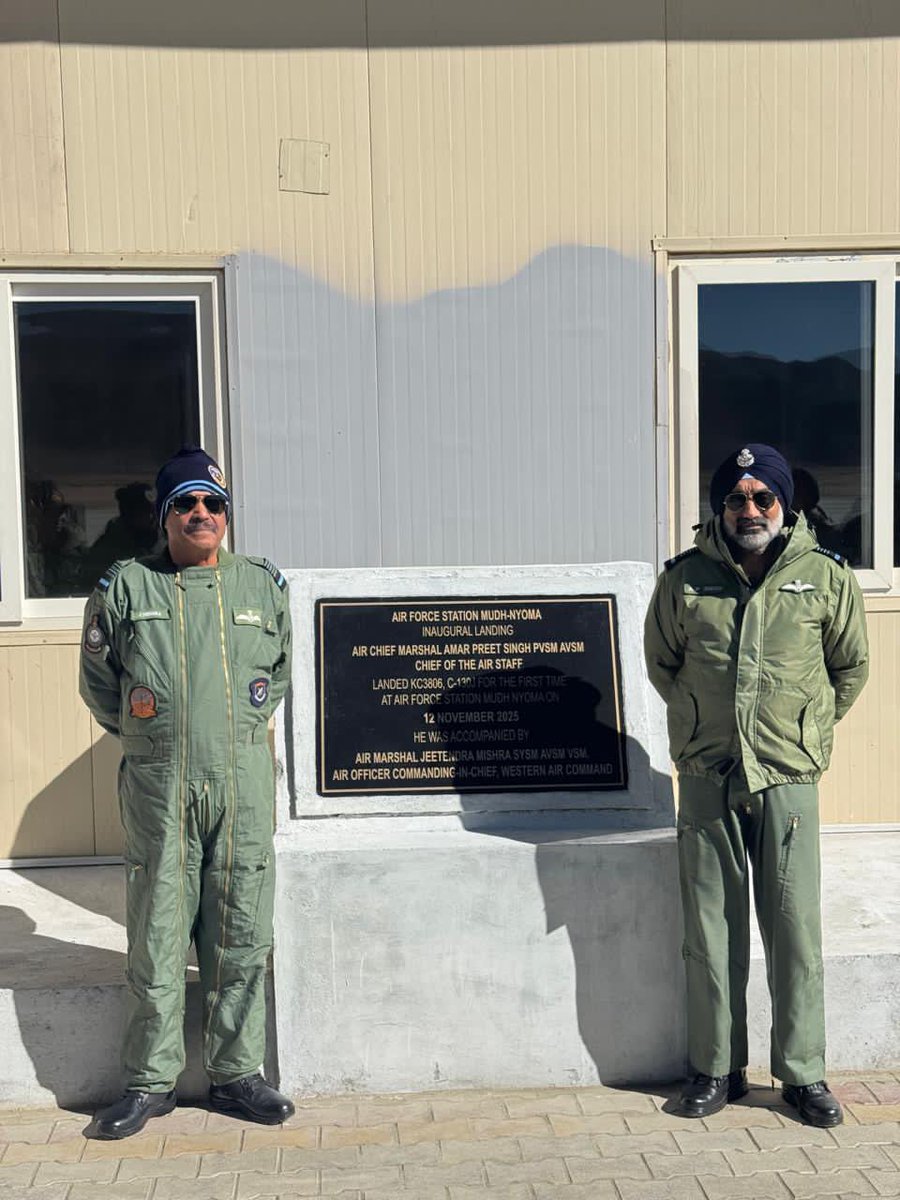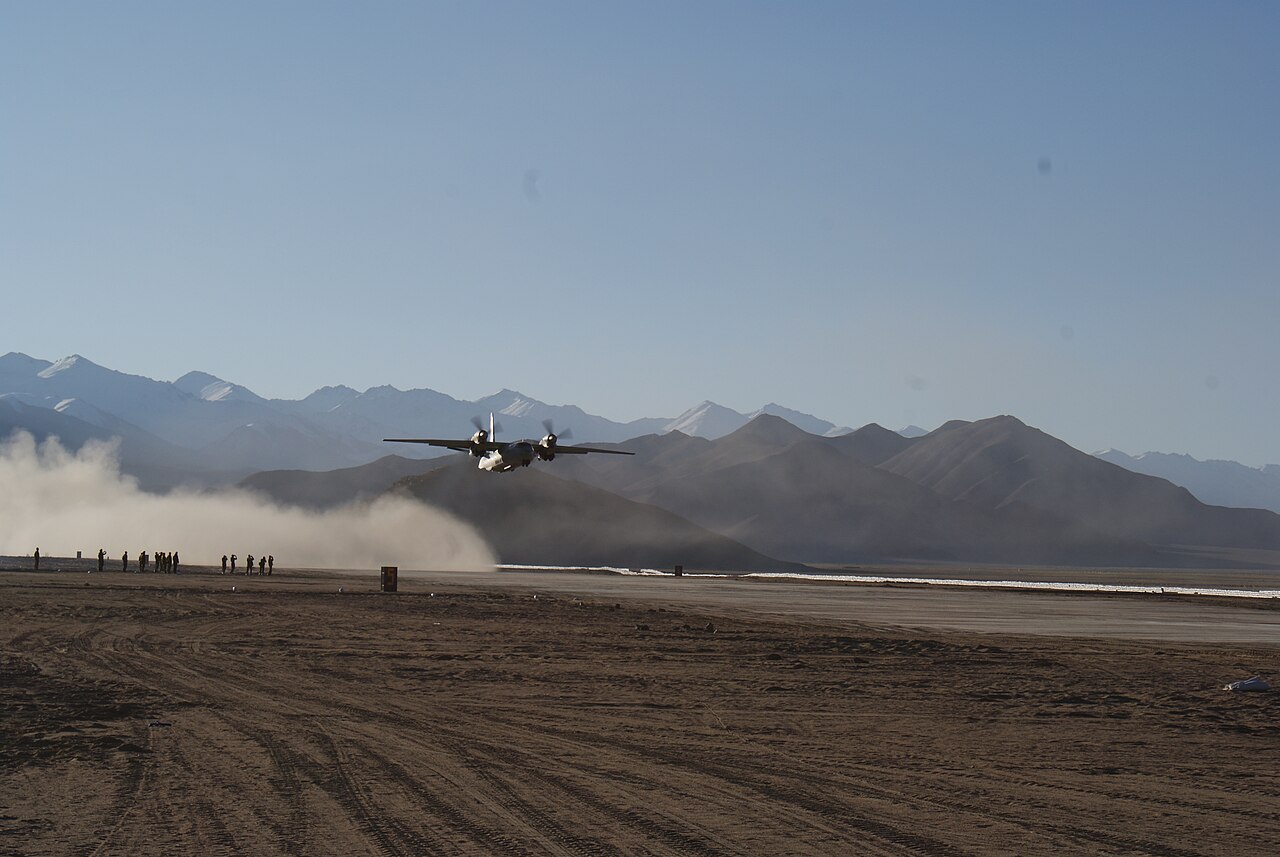In a major boost to India’s military readiness along the Line of Actual Control (LAC), the Indian Air Force has operationalised the strategically vital Nyoma Advanced Landing Ground, barely 40 km from the disputed border in eastern Ladakh.
The ties between India and China may have somewhat normalized, but the territorial dispute between the two countries is still far from over, which means another round of border clashes between the two Asian giants cannot be ruled out.
To bolster its defences and enhance reaction time to a future contingency, India recently commissioned the Mudh-Nyoma airbase, with the landing of a C-130J special operations aircraft by the Chief of the Air Staff (CAS) Air Chief Marshal A.P. Singh.
Located at the dizzying height of 13,700 feet, the Nyoma Air Base is the highest operational fighter base in the world and can be termed an engineering marvel. It sits merely 25-50 kilometres away from the de facto LAC. The commissioning of the airbase has been seen as a breakthrough for India’s infrastructure push at the frontline.
With a 2.7-kilometre runway, the fully functional air base can be used by helicopters such as Apache and Chinook that have been flying along the contested border since the 2020 Galwan crisis, cargo aircraft such as C-17 Globemaster III and IL-76 for transporting men and materiel, and fighter jets such as the Su-30MKI, which forms the backbone of the Indian Air Force (IAF) fighter fleet. The air base will also potentially be used by the Rafale and the MiG-29 UPG, the other two ace fighters of the IAF.

With winter temperatures dropping to -30°C to -35°C, BRO (Border Road Organisation) engineers endured harsh conditions during construction. Despite the difficulties, the project was finished within a year after the groundbreaking, which officials called “a testament to the dedication and technical expertise” of the participating teams.
The Nyoma Air Base has had a long, incremental journey that spans over five decades, driven by repeated military crises with China. On 18 Sep 2009, an AN-32 aircraft of the IAF landed at Nyoma. This was the first landing of a fixed-wing aircraft at Nyoma Advanced Landing Ground (ALG).
Indian Defence Minister Rajnath Singh laid the foundation stone of Nyoma Airfield in eastern Ladakh in September 2023, under the shadow of the 2020 Galwan crisis, which saw Indian and Chinese soldiers standing eyeball-to-eyeball at multiple friction points along the contested border.
The border standoff ended in October last year with a breakthrough pact signed on patrolling arrangements along the LAC in eastern Ladakh, resolving friction points at Depsang and Demchok—the last major standoff sites from 2020. This allowed the restoration of pre-2020 patrolling rights, with troops disengaging and dismantling temporary structures built over the previous four years.
The two sides have since made concerted efforts to normalise ties, as evidenced by high-level visits by Minister of External Affairs S. Jaishankar and Prime Minister Narendra Modi.
Both sides are now issuing tourist visas, and direct flights have resumed. In fact, China also displayed rare bonhomie when it criticised US President Donald Trump’s decision to impose unprecedented tariffs against New Delhi.
However, this does not fundamentally change the situation on the ground, as territorial disputes persist and both sides have different interpretations of the border.
Moreover, the October 2024 agreement has not slowed down China’s military activity along the border. For example, in January 2025, China tested high-altitude technology in the precarious post-disengagement ceasefire by conducting military drills near the LAC in eastern Ladakh using exoskeletons, drones, and all-terrain vehicles.
The satellite imagery from 2024–2025 revealed several new Chinese projects, including an air-defence complex near Pangong Lake, a 91-structure “Xiaokang” dual-use village near Spanggur Lake, cement plants, and communication towers—potentially supporting logistics for PLA units. China’s 2025 defence budget rose 7.2% to $245 billion, with provisions for further funding of border enhancements.
Therefore, India has continued construction of its own infrastructure and expansion of military activity in Eastern Ladakh, primarily to prepare for any eventualities. The Nyoma airbase is, undoubtedly, the most significant part of that strategy.

Nyoma Air Base— Himalayan Fortress To Deter China
As the world’s highest fighter-capable airfield, the Nyoma Air Base significantly bolsters India’s military posture along the northern frontier.
The airbase is strategically situated, with the central region of Pangong Tao being just 50 kilometres to the north. The Nyoma airbase is merely 100 kilometres from China’s strategic G219 highway, which passes through Aksai Chin and connects China’s Xinjiang and Tibet regions, allowing for faster troop and supply movement to its western border.
Moreover, it is just 180 kilometres from the Ngari Kunsa airport, which is believed to have dual-use applications and is expected to be used in the event of a contingency. It is similarly situated close to critical friction points like Demchok, Depsang Plains, and Chushul.
Indian Air Force veteran fighter test pilot, Air Marshal Anil Chopra (retd), told the EurAsian Times that the operationalisation of the Nyoma airbase is a genuine game-changer.
“At 13,700 ft and barely 35 km from the LAC, it is now the highest fighter-capable airbase on the planet. The IAF, along with BRO, has turned a 1962 dirt strip into a full-fledged forward arm with a 2.7 km paved runway, hardened shelters, and the ability to generate Su-30 MKI, C-17, and Chinook sorties within minutes of an alert.”
Nyoma would give India a closer, faster reaction node in eastern Ladakh. The proximity to LAC would allow Indian aircraft to achieve faster time-on-target—potentially reducing reaction times compared to rearward sites such as the Leh and Srinagar air bases. In an air conflict scenario, it would primarily function as a quick-reaction launch site for fighter jets and helicopters to counter enemy air assets originating from neighbouring bases.
However, it would also be just as useful in a non-combat scenario. “Beyond combat, Nyoma will also enhance Intelligence, Surveillance, and Reconnaissance (ISR) missions through unmanned aerial vehicles (UAVs) and fixed-wing aircraft,” Air Marshal Anil Khosla (retd), the former Vice Chief of Air Staff (VCAS) of the Indian Air Force and AOC in C of Eastern Air Command, explained to the EurAsian Times.
“Nyoma complements other airfields, providing redundancy and responsiveness. Opening a new high-altitude base itself signals a stronger intent,” he added.
The upgraded Nyoma airbase will support the full-scale operations of heavy strategic airlift aircraft such as the C-17 Globemaster III and Il-76, enabling the rapid deployment of troops and heavy equipment, including tanks, artillery, and air defence systems.
Moreover, the fighter squadrons will be deployed to Nyoma on a rotational basis. UAVs and armed helicopters like the ALH Rudra and AH-64 Apache, already active in Ladakh since the 2020 standoff, will now be able to operate routinely from this base.
There are challenges associated with operating an air base at extremely high altitudes. Heated hangars are necessary for aircraft maintenance and repairs. Additionally, certain storage conditions are required for oils, lubricants, some electronic devices, and avionics. There is a short window—six to seven months—for infrastructure repairs and civil works. Thus, making operations challenging.
When asked about the challenges associated with operating the world’s highest airbase, Air Marshal Chopra said, “Operating fighters at that altitude in –40 °C winters, 70-knot winds, and summer density altitudes that can push 18,000 ft remains a brutal engineering and physiological challenge. Every gallon of JP-8 has to be heated, every mechanic works in arctic gear, and the base is well within range of Chinese 155 mm artillery and long-range rockets.
Meanwhile, there is the influence of “hot and high” operations in summer, necessitating longer runway length for take-off or compromising on overall load.”
However, the IAF has been operating in high-altitude regions for decades. With the right funding and strict oversight, the operations could be streamlined and the impact of harsh weather on maintenance cushioned.
Notably, the proximity to the LAC makes the base vulnerable to attack. Air Marshal Khosla said, “The air threat is very real for a forward base like Nyoma. It will also be vulnerable to low-cost, high-impact drone attacks. A layered counter-UAS and survivability plan would include hardening, dispersal, EW, and C-UAS sensors/shooters. It would have to be integrated with air defence and operational adjustments (dispersal, rotation, redundant basing, and mission prioritisation).
Meanwhile, another IAF veteran and expert, Squadron Leader Vijainder K. Thakur (retd), told the EurAsian Times, “Nyoma airbase has likely been spruced up and a runway built for transport operations. It will be used to deploy and support troops & equipment. During wartime, it’s unlikely that air assets other than helicopters & drones will be based there. Aircraft will come & go. Runways are easily repaired when struck.”
Despite the persisting threats, which are also common for other bases located close to the border with Pakistan, the Nyoma Air Base is a tactical breakthrough as it forms “Ladakh Air Grid” with bases at Leh, Kargil, Thoise, DBO, and Fukche, enabling sustained air operations, drone/UAV operations, and composite air-ground coordination.
- Contact the author at sakshi.tiwari13 (at) outlook.com
- Follow EurAsian Times on Google News




